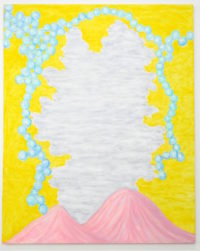
23 March – 27 April, 2019
Opening reception: 18.00-20.00 on 23 Mar.
Closed on Sun., Mon., and public holidays
Among the works of Tokuoka Shinsen (1896-1972) is Camellia (1922) (collection of the National Museum of Modern Art, Tokyo). At 102.1 by 86.8 cm, it is not a very large work, but there is a somehow eerie and unreal aspect to the depiction of a camellia tree filling the pictorial space and spilling over the edges, its blooming flowers and lush foliage seemingly floating in a void.
A similar quality can be seen in one of Hasegawa Shigeru’s new works scheduled
to be shown in this exhibition, depicting something like a teapot surrounded by
cucumbers. The teapot is both like and not like a teapot (the same can be said of
the cucumbers), and painted above them in a pure shade of yellow appear to be
some sort of citrus fruits (although they may not be). The gray area at the edge
of the picture resembles both draped fabric and a line of hills.
As suggested by Hasegawa’s titling his exhibition PAINTING, the painting described
above is nothing besides just that, and to demand that it be something more than
that may be making grossly unjustified assumptions.
Nonetheless, there is a feeling of both exhilaration and discomfort like biting on
sand in one’s food, a hazy, cryptic quality that makes the viewer seek some small
clue as to what he or she is seeing and why the artist chose to paint it. The untitled
works withhold the information we seek, and we go back to the painting and
examine it again for clues, with a feeling like going around in circles. It is as if our
attitude toward viewing Hasegawa’s painting is being tested, and we cannot help
but tense up in response. What we seek to obtain from Hasegawa’s painting is
something that can only come from within oneself, and viewing it brings us face to
face with our own depth of knowledge and receptivity.
What does Hasegawa Shigeru paint?
Why does Hasegawa Shigeru paint?
How does Hasegawa, who was long based in Europe, interpret PAINTING? He has
evidently given profound and prolonged thought to what constitutes his own
PAINTING, the result of which is a body of work conveying obsession, bordering on
the mad, with asserting its own unique identity.
This solo exhibition features six new and recent works by Hasegawa as well as older
work, and is his first in nine years after a lengthy period of silence. We sincerely hope
you will visit the gallery while the exhibition is on view.